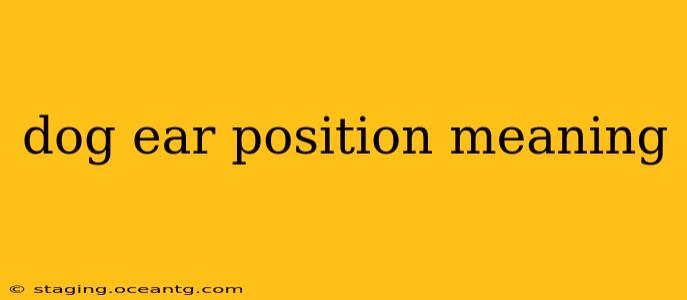Understanding canine body language is crucial for responsible dog ownership and building a strong human-animal bond. One subtle yet important aspect is the position of a dog's ears. While a dog's ears can communicate a wide range of emotions and intentions, let's delve into the meaning behind a "dog ear position," exploring various positions and what they might signify.
What Does it Mean When a Dog's Ears are Pricked Forward?
Pricked ears, pointed straight up and forward, often indicate alertness and attentiveness. Your dog may be focused on something interesting in their environment, perhaps a sound, sight, or scent. This isn't necessarily a sign of aggression but rather curiosity and engagement with their surroundings. However, the context is important. If coupled with a stiff body and intense stare, it could signal potential aggression.
What Does it Mean When a Dog's Ears are Back?
Ears flattened against the head, or pulled back, usually signal fear, anxiety, or submission. A dog displaying this posture may be trying to make themselves appear smaller and less threatening. It’s crucial to respect this signal and avoid any actions that might escalate their anxiety. This is a clear sign to give the dog space and avoid any direct interaction.
What Does it Mean When a Dog's Ears are Droopy?
While droopy ears are a breed characteristic for some dogs (like Basset Hounds), in others, it can indicate relaxation or contentment. A relaxed dog with slightly droopy ears might be enjoying a nap or simply chilling out. However, if combined with other submissive signals like a tucked tail or lowered posture, it could also point to fear or insecurity.
What Does it Mean When One Ear is Forward and One is Back?
This asymmetrical ear position often suggests confusion or uncertainty. The dog might be trying to process conflicting information or is unsure about a situation. It's a sign that your dog is experiencing cognitive dissonance and needs time to assess their environment. Observe the dog’s overall body language for further clues.
How Can I Tell the Difference Between a Playful and Aggressive Dog Based on Ear Position?
While ear position is a helpful clue, it's crucial to consider the entire body language. A playful dog might have slightly pricked ears, a relaxed body posture, and a wagging tail. An aggressive dog, on the other hand, will likely have tense muscles, a stiff body, and possibly bared teeth, even with ears in varying positions. The context of the situation—what’s happening around them—is equally crucial.
What Other Body Language Signals Should I Look For Along With Ear Position?
Pay close attention to the entire picture: tail wag, body posture (tense vs. relaxed), mouth (open, closed, panting), and overall demeanor. Combining these cues will give you a much clearer understanding of your dog’s emotional state.
Why is it Important to Understand Dog Ear Position?
Understanding dog ear positions and their meaning is vital for responsible dog ownership. It allows you to better interpret your dog’s emotional state, respond appropriately, and build a stronger, more harmonious relationship. By understanding these subtle cues, you can prevent misunderstandings and avoid potentially stressful situations for your canine companion.
Disclaimer: This article provides general information about dog body language. If you have concerns about your dog’s behavior, consult a certified veterinary behaviorist or professional dog trainer for personalized advice.
